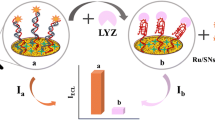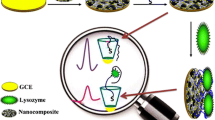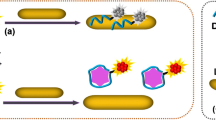Abstract
Lysozyme aptamer-functionalized magnetic alginate hydrogel was prepared for separation and enrichment of lysozyme. Luminol-labeled aptamer was used as a signal tag, and the signal tag was adsorbed on magnetic carboxylated carbon nanotubes based on the π-interaction. When lysozyme was added, the aptamer specifically binds to the lysozyme, causing the signal tag to detach from the magnetic carboxylated carbon nanotubes. When the aptamer/lysozyme complex bound to the complementary single strand of aptamer on the hemin@HKUST-1, lysozyme was released. The released lysozyme can be recombined with the signal tag adsorbed on the magnetic carboxylated carbon nanotube, allowing more signal tag to be dispersed into the solution. Determination of lysozyme was achieved by releasing the luminol-labeled aptamer to generate a chemiluminescence signal at a wavelength of 425 nm. It was proved by experiments that the synthesized hemin@HKUST-1 had a strong catalytic effect on the luminol-NaOH-H2O2 system. The chemiluminescence signal was increased nearly 100 times. The complementary pairing allowed the luminol to be immobilized on the surface of hemin@HKUST-1. The generation and consumption of short-lived reactive oxygen species were concentrated on the surface of the MOFs, which improves the chemiluminescence efficiency. The introduction of hemin@HKUST-1 and DNA solved the defects of chemiluminescence analysis. The chemiluminescence assay was able to detect lysozyme with linear range of 1.05 × 10−6 U∙mg−1 (6.00 × 10−13 mol∙L−1)–1.25 × 10−2 U∙mg−1 (7.14 × 10−9 mol∙L−1); the detection limit was 3.50 × 10−7 U∙mg−1 (2.00 × 10−13 mol∙L−1) (R2 = 0.99). The recovery of lysozyme in spiked saliva samples was 97.4–102.8%.

Schematic presentation of chemiluminescence assay. Lysozyme (Lys) was captured by aptamer-modified magnetic sodium alginate (M-Alg-Apt); Glycine (pH = 2) as eluent for Lys. Luminol-modified Apt (Apt-luminol) as signal tag; magnetic carbon nanotubes (MCNTs) as adsorption matrix; cDNA was complementary to Apt; hemin@HKUST-1 as catalyst.





Similar content being viewed by others
References
Li FK, Gong AJ, Qiu LN, Zhang WW, Li JR, Liu Z (2019) Diglycolamide-grafted Fe3O4/polydopamine nanomaterial as a novel magnetic adsorbent for preconcentration of rare earth elements in water samples prior to inductively coupled plasma optical emission spectrometry determination. Chem Eng J 361:1098–1109
Wei J, Yang ZX, Sun Y, Wang CK, Fan JL, Kang GY, Zhang R, Dong XY, Li YF (2019) Nanocellulose-based magnetic hybrid aerogel for adsorption of heavy metal ions from water. J Mater Sci 54:6709–6718
Huang D, Wu JZ, Wang L, Liu XM, Meng J, Tang XJ, Tang CX, Xu JM (2019) Novel insight into adsorption and co-adsorption of heavy metal ions and an organic pollutant by magnetic graphene nanomaterials in water. Chem Eng J 358:1399–1409
Mortazavi-Derazkola S, Salavati-Niasari M, Khojasteh H, Amiri BO, Ghoreishi SM (2017) Green synthesis of magnetic Fe3O4/SiO2/HAp nanocomposite for atenolol delivery and in vivo toxicity study. J Clean Prod 168:39–50
Alupei L, Peptu CA, Lungan AM, Desbrieres J, Chiscan O, Radji S, Popa M (2016) New hybrid magnetic nanoparticles based on chitosan-maltose derivative for antitumor drug delivery. Int J Biol Macromol 92:561–572
Wu K, Jing CY, Zhang J, Liu T, Yang SJ, Wang WD (2019) Magnetic Fe3O4@CuO nanocomposite assembled on graphene oxide sheets for the enhanced removal of arsenic(III/V) from water. Appl Surf Sci 466:746–756
Sun JH, Chen Y, Yu HQ, Yan LG, Du B, Pei ZG (2018) Removal of Cu2+, Cd2+ and Pb2+ from aqueous solutions by magnetic alginate microsphere based on Fe3O4/MgAl-layered double hydroxide. J Colloid Interface Sci 532:474–484
Yu C, Sun H, Hou SF (2017) Direct electrochemistry and electrocatalysis of myoglobin immobilized in calcium alginate-graphene microspheres films. Anal Methods 9:4873–4881
Nirala NR, Pinker N, Desitti C, Shtenberg G (2019) Milk haptoglobin detection based on enhanced chemiluminescence of gold nanoparticles. Talanta 197:257–263
Bodulev OL, Gribas AV, Sakharov IY (2018) Microplate chemiluminescent assay for HBV DNA detection using 3-(10′-phenothiazinyl)propionic acid/N-morpholinopyridine pair as enhancer of HRP-catalyzed chemiluminescence. Anal Biochem 543:33–36
Karan R, Capes MD, DasSarma S (2012) Function and biotechnology of extremophilic enzymes in low water activity. Aquat Biosyst 8:4–18
Meng R, Liu Q, Jin Y, Li BX (2018) Dual-hemin-labelled catalytic molecular beacon: a monomer-dimer switching probe for sensitive chemiluminescence detection of biomolecules. ChemistrySelect 3:1908–1914
Zhou Z, Hartmann M (2013) Progress in enzyme immobilization in ordered mesoporous materials and related applications. Chem Soc Rev 42:3894–3912
Liu X, Qi W, Wang YF, Su RX, He ZM (2017) A facile enzyme immobilization strategy with high stable hierarchically porous metal-organic frameworks. Nanoscale 9:17561–17570
Alizadeh N, Salimi A, Hallaj R, Fathi F, Soleimani F (2018) Ni-hemin metal-organic framework with highly efficient peroxidase catalytic activity: toward colorimetric cancer cell detection and targeted therapeutics. J Nanobiotechnol 16:93–106
Luo FQ, Lin YL, Zheng LY, Lin XM, Chi YW (2015) Encapsulation of hemin in metal-organic frameworks for catalyzing the chemiluminescence reaction of the H2O2-luminol system and detecting glucose in the neutral condition. ACS Appl Mater Interfaces 7:11322–11329
Revenis ME, Kaliner MA (1992) Lactoferrin and lysozyme deficiency in airway secretions: association with the development of brochopulmonary dysplasia. J Pediatr 21:262–270
Tomita H, Sato S, Matsuda R, Sugiura Y, Kawaguchi H, Niimi T, Yoshida S, Morishita M (1999) Serum lysozyme levels and clinical features of sarcoidosis. Lung 177:161–167
Chen ZX, Xu Q, Tang GX, Liu S, Xu SX, Zhang XF (2019) A facile electrochemical aptasensor for lysozyme detection based on target-induced turn-off of photosensitization. Biosens Bioelectron 126:412–417
Dionisia O, Valle M (2018) Label-free aptasensor for lysozyme detection using electrochemical impedance spectroscopy. Sensors 18:354–364
Zhang ZH, Zhang S, He LH, Peng DL, Yan FF, Wang MH, Zhao JH, Zhang HZ, Fang SM (2015) Feasible electrochemical biosensor based on plasma polymerization-assisted composite of polyacrylic acid and hollow TiO2 spheres for sensitively detecting lysozyme. Biosens Bioelectron 74:384–390
Dong YP, Wang J, Peng Y, Zhu JJ (2017) A novel aptasensor for lysozyme based on electrogenerated chemiluminescence resonance energy transfer between luminol and silicon quantum dots. Biosens Bioelectron 94:530–535
Ding WH, Guan LM, Han JJ, Mangala R, Luo ZX (2017) Fluorescence chemosensing of water-soluble Ag14 nanoclusters for lysozyme and Hg2+ ions. Sensors Actuators B Chem 250:364–371
Li J, Mu XJ, Chan KC, Ko CC, Li MJ (2018) Sensitive determination of lysozyme by using a luminescent and colorimetric probe based on the aggregation of gold nanoparticles induced by an anionic ruthenate(II) complex. Microchim Acta 185:428–433
Guo YP, Zhou Y, Jia DC, Meng QC (2008) Fabrication and in vitro characterization of magnetic hydroxycarbonate apatite coatings with hierarchically porous structures. Acta Biomater 4:923–931
Chen J, Yu C, Zhao YL, Niu YZ, Zhang L, Yu YJ, Wu J, He JL (2017) A novel non-invasive detection method for the FGFR3 gene mutation in maternal plasma for a fetal achondroplasia diagnosis based on signal amplification by hemin-MOFs/PtNPs. Biosens Bioelectron 91:892–899
Shrivas K, Nirmalkar N, Deb MK, Dewangan K (2019) Jayant Nirmalkar, Suneel Kumar, Application of functionalized silver nanoparticles as a biochemical sensor for selective detection of lysozyme protein in milk sample Spectrochim Acta A Mol Biomol Spectrosc 213:127–133
Zeng Y, Zhang D, Qi P, Zheng LB (2018) Label-free simultaneous sensor for multi-components detection based on G-Quadruplex DNA structure. Sensors Actuators B Chem 265:468–475
Du FK, Zhang H, Tan XC, Yan J, Liu M, Chen X, Wu YY, Feng DF, Chen QY, Cen JM, Liu SG, Qiu YQ, Han HY (2018) Ru(bpy)32+-silica@poly-L-lysine-Au as labels for electrochemiluminescence lysozyme aptasensor based on 3D graphene. Biosens Bioelectron 106:50–56
Fu F, Li LY, Luo QM, Li QJ, Guo TG, Yu MQ, Song Y, Song EQ (2018) Selective and sensitive detection of lysozyme based on plasmon resonance light-scattering of hydrolyzed peptidoglycan stabilized-gold nanoparticles. Analyst 143:1133–1140
Cao XY, Xu JY, Xia JF, Zhang FF, Wang ZH (2018) An electrochemical aptasensor based on the conversion of liquid-phase colorimetric assay into electrochemical analysis for sensitive detection of lysozyme. Sensors Actuators B Chem 255:2136–2142
Saha S, Venkatesh M, Basu H, Pimple MV, Singhal RK (2019) Recovery of gold using graphene oxide/calcium alginate hydrogel beads from a scrap solid state detector. J Environ Chem Eng 7:103134–102140
Funding
This work was supported by the Shandong Provincial Natural Science Foundation of China (No. ZR2016BM01), Horizontal Scientific Research Project of China (No. W15077), National Natural Science Foundation of China (No. 21605094), The Youth Science fund of Shandong Academy of Sciences (No. 2017QN006), and Shandong Province Natural Science Institute Joint Fund (No. ZR2015YL006).
Author information
Authors and Affiliations
Corresponding authors
Ethics declarations
Conflict of interest
The authors declare that they have no competing interest.
Additional information
Publisher’s note
Springer Nature remains neutral with regard to jurisdictional claims in published maps and institutional affiliations.
Electronic supplementary material
ESM 1
(DOCX 2379 kb).
Rights and permissions
About this article
Cite this article
Lin, Y., Sun, Y., Dai, Y. et al. A chemiluminescence assay for determination of lysozyme based on the use of magnetic alginate-aptamer composition and hemin@HKUST-1. Microchim Acta 187, 281 (2020). https://doi.org/10.1007/s00604-020-04254-2
Received:
Accepted:
Published:
DOI: https://doi.org/10.1007/s00604-020-04254-2




